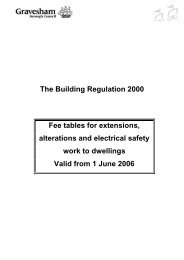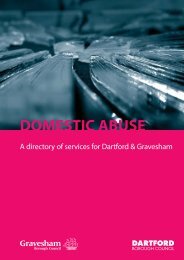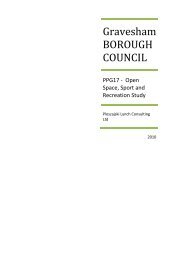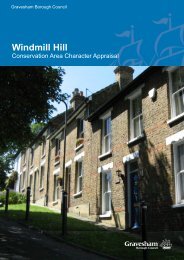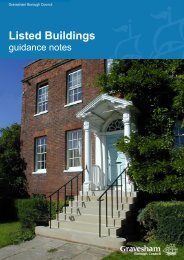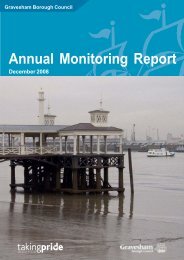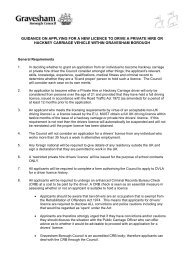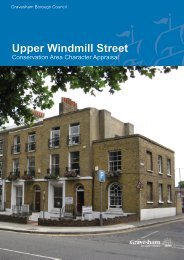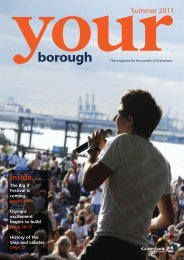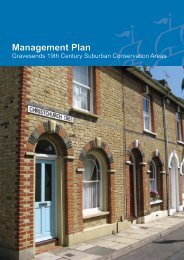gravesend riverside conservation area - Gravesham Borough Council
gravesend riverside conservation area - Gravesham Borough Council
gravesend riverside conservation area - Gravesham Borough Council
Create successful ePaper yourself
Turn your PDF publications into a flip-book with our unique Google optimized e-Paper software.
Riverside Conservation Area Appraisal 2009<br />
9<br />
Area as part of the New Tavern Fort. It<br />
was a religious institution that owned<br />
considerable land in the <strong>area</strong>, on the<br />
outskirts of the fledgling town.<br />
• The town grew under various lordships<br />
including the crown, nobility and the<br />
Cistercian Abbey of the St Mary Graces in<br />
London.<br />
• 1380 - French and Spanish warships<br />
attacked Gravesend. Most of the town<br />
was destroyed. In recompense Richard<br />
II granted the people of Gravesend sole<br />
rights to ferry passengers to London giving<br />
rise to Gravesend’s growth as a maritime<br />
centre and trading port.<br />
• Gravesend Watermen operated open<br />
barges, the Long Ferry, and transported<br />
passengers to and from the Pool of<br />
London. Larger, ocean-going vessels<br />
continued out along the estuary to the<br />
international destinations beyond.<br />
• River related occupations, including,<br />
ferrying, victualling, rope and sail making<br />
and boat building and repairing, occupied<br />
the majority of the town’s inhabitants.<br />
TUDOR AND JACOBEAN (1485 – 1714):<br />
• 1539/ 40 - Blockhouses erected at<br />
Gravesend, Tilbury, Milton and Higham to<br />
defend London from attack.<br />
• 1562 - Charter of Incorporation united the<br />
two parishes of Milton and Gravesend.<br />
• 1650 - All landing stages except for the<br />
common bridge (Town Pier) removed.<br />
• 1709 - Gravesend to Rochester Road (in<br />
part Milton Road) created.<br />
• 1711 - Turnpike Act led to stagecoach<br />
route along Milton Road at the top of<br />
Milton Place.<br />
GEORGIAN & REGENCY (1714 – 1837):<br />
• Throughout this period Gravesend grew,<br />
but was often destroyed by fires.<br />
• 1726 - 160 houses at Milton.<br />
• 1782 - New Tavern Fort constructed.<br />
Customs House constructed. Later to<br />
become Whitehall Place and, after partial<br />
demolition, is no.47 The Terrace.<br />
• 1797 - Gravesend population was 4,000,<br />
with 700 houses in nine streets, including<br />
The Terrace.<br />
• 1791 – 32 houses called the Terrace built<br />
between New Tavern village and the town<br />
of Gravesend by James Leigh Joynes.<br />
• 1800 – First Act of Parliament passed<br />
granting the construction of the Thames<br />
and Medway Canal.<br />
• Early 1800s – Albion swimming baths<br />
established to the east of the Canal Basin.<br />
Failed to rival Clifton Baths in Northfleet.<br />
• 1813 – Wates’s Hotel established by the<br />
river.<br />
• 1815 – New house erected on south<br />
side of The Terrace on the site of the<br />
Old Fountain Public House. Later to be<br />
occupied by customs and excise.<br />
• 1815 - First regular service of pleasure<br />
steamers from London to Gravesend.<br />
• 1824 – Thames and Medway Canal finally<br />
opened.<br />
• 1825 – Customs and Excise merged and<br />
moved into the former Old Fountain Public<br />
House.<br />
• 1826 – Obelisk erected on site of the<br />
Round Tree, used to mark the limits<br />
for charging duty on coal entering<br />
London. This was also the site of Milton<br />
Blockhouse.<br />
• 1828 - Gravesend and Milton Steamboat<br />
Company formed.<br />
• 1834 - Blockhouse Fort site sold and<br />
developed as Terrace Gardens.<br />
• 1836 - Gravesend Freehold Investment




